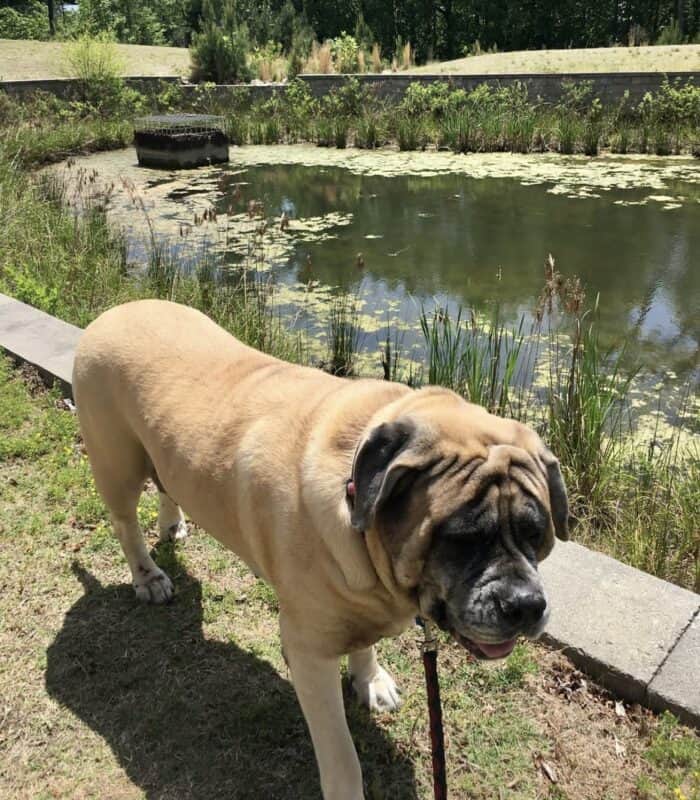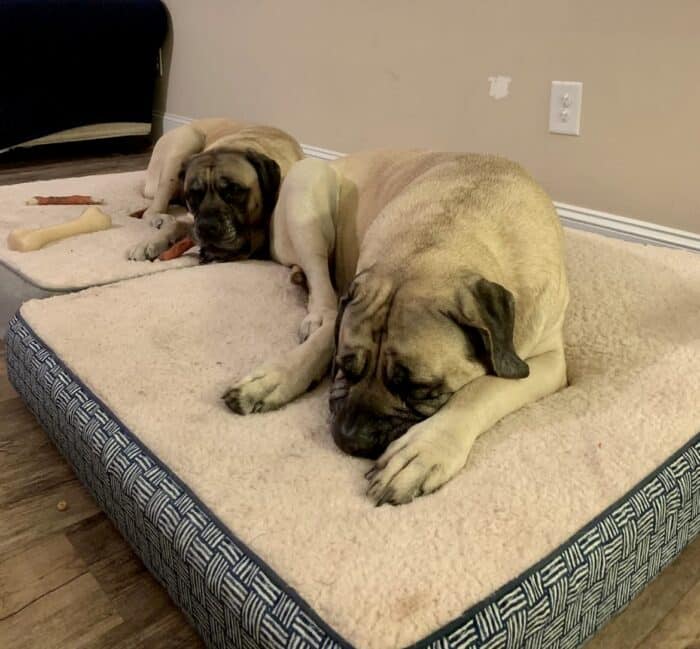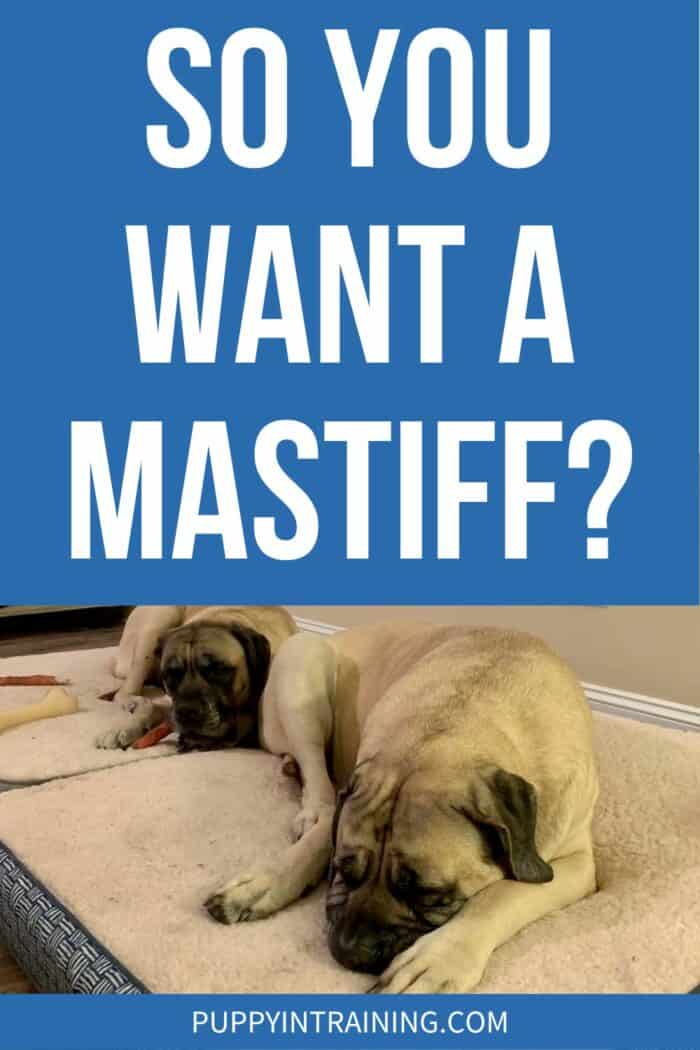This post may contain affiliate links. We may earn money or products from the companies mentioned in this post.
So you want a Mastiff?
This powerful, square dog makes an impressive entrance wherever they go.
Mastiffs can weigh up to a jaw dropping 230 lbs! The Mastiff is a giant breed with a wrinkly face & forehead that may very well outweigh you!
Keeping that in mind, they can make a great furry buddy to snuggle up next to.

Keep on reading to find out if they may be the right four-legged companion for you and/or your family.
Spoiler alert: While we’ll share the good, you’ll also get to read about the bad & the ugly of Mastiffs.
10 Facts Good & Bad About Mastiffs
1. Mastiffs Are Working Dogs With Low Exercise Needs
This one may hit you as a surprise: While Mastiffs were originally used as war dogs, guard dogs and to help hunt big game in ancient England, they actually have fairly low exercise needs.
Keeping that in mind, they do perfectly fine with two 30-45 minute daily walks at a medium pace.
While they’re good-natured, calm and affectionate, they also tend to be a bit on the stubborn side.
So don’t be surprised if your big pup hits the brakes on a walk, sits down and decides they’re done walking.
At least in that direction!
That happened to me a few times back in my professional dog walking days.
When it did, we just turned back around and headed back home.
However, their stubborn side doesn’t take away from their courage which makes them protective of their family and turns them into a great watchdog.
2. They Have A Short Life Expectancy Compared to Other Breeds
Unfortunately and as all extra large dog breeds, Mastiffs have a fairly short life expectancy of only 6-10 years.
It’s always hard to have to say goodbye to our furry friends after a lifetime together, so when it’s cut short by 5-8 years due to their size, it’s extra heart breaking.
Are you prepared to handle that?

3. Mastiffs Are Prone to Bloating
Bloat happens when the stomach turns on itself and cuts off the air and blood supply to vital organs.
It can be fatal even when it gets treated quickly by a vet, so it’s important to be aware of the symptoms and to try and avoid it in the first place.
When dogs are bloating, the skin across their belly feels and looks tight like a drum. Additionally, they’ll try to throw up but can’t, so you’ll notice unproductive retching.
Bloat is known to happen when dogs drink large amounts of water at once as well as when they exercise right after a large meal.
So, don’t give your Mastiff buckets of water and hold off on exercise and playtime for 1-2 hours after meals.
A strict dry dog food diet paired with elevated dog feeders is known to cause bloating as well.
What you can do is add a little water, bone broth or goat’s milk to their kibble and place their bowls on the ground.
Other alternatives are canned dog food, homemade dog food and raw dog food.
4. Watch Out For Hip Dysplasia In Your Mastiff
The Hip Dysplasia gene can be passed from one generation to the next, which is why responsible Mastiff breeders test the dogs they intend to breed for it.
Dogs who suffer from hip dysplasia have malformed joints that cause arthritis paired with intense amounts of pain.
It’s aggravated by excess weight and a diet that doesn’t have the proper balance of Omega-3 to Omega-6 fatty acids.
That said, please do your Mastiff a giant favor, pun intended, and keep them at a healthy weight along with feeding them a nourishing diet.
A general rule of thumb is that you don’t want your Mastiff’s ribs covered in layers of fat.
Additionally, their belly should not be sagging.
Many commercial dog diets are too rich in Omega-6 fatty acids as chickens, grains, corn and soy are major components.
Grains, corn and soy are rich in Omega-6 fatty acids that cause inflammation within the body. As most chickens are fed diets rich in grains and soy, they turn into inflammatory ingredients as well.
Foods that are rich in Omega-3s are oily fish like salmon, herring, trout, mackerel, sardines and anchovies.
Bone broth is naturally rich in glucosamine and chondroitin both of which help support joint health.
That’s why it’s a good idea to add it to your pup’s diet on a regular basis.
Orthopedic extra large beds will help your giant pup be comfy and provide support for their hurting joints in their senior years.

5. You’ll Need to Keep A Cloth Around Mastiffs
Everything on Mastiffs is huge, including their jowls.
That’s why this breed slobbers quite a bit and is also known to distribute drool more or less evenly across your home…
That doesn’t just include your furniture, but also your walls and ceilings.
So if you’re planning on bringing a Mastiff home to live with you, you may want to consider repainting with a wall color that’s easy to clean.
Either way, you’ll definitely need a cloth to wipe your Mastiff’s jowls with.
You’ll also need a soft cloth to care for their wrinkly face. It’s important to regularly wipe their wrinkles to keep drool and other debris from accumulating in there.
6. Mastiffs Have Unique Grooming Challenges
Unlike their jowls that need lots of attention, Mastiffs have short brindle, fawn or apricot colored coats that are easy to care for.
A few weekly brushings with a grooming glove or brush is all they need.
That’s the good news.
However, bath time may be challenging if you don’t have a walk-in shower that’s large enough to accommodate your giant pup.
I say walk-in shower because unless your pup is willing to “climb” into your tub, you’ll have a hard time lifting them in there once they’re fully grown.
An alternative can be a bath in your yard, at least during the warmer months.
Other than that, you can see about taking them to a doggie self wash or a professional groomer.
Mobile groomers may not have the space to accommodate your Mastiff in their van.
7. Their Flat Face Makes Them Prone to Two Things
Mastiffs have beautiful black masks with cute looking noses.
Unfortunately, they’re also brachycephalic, which means they have shortened nasal passages.
That means they can’t pant and cool themselves off as effectively as dogs with regularly sized nasal passages.
So it’s important to monitor them closely for overheating, especially during the warmer summer months.
Additionally, Mastiffs are known to snore, so that’s something else to be aware of if you’re thinking of inviting them into your bedroom!
8. They’re A “Gentle Giant”, But…
While Mastiffs are good with children and make a wonderful family dog, you’ll want to watch your space around them!
Particularly your feet.
I’ve had the questionable pleasure of having a giant Mastiff girl step onto my toes, and it was not a good feeling.
Thankfully, I wasn’t barefoot but wore shoes, but I still don’t recommend the experience.
9. Prepare for Oversized Everything
Extra large dogs like Mastiffs come with extra large accessories, there’s just no way around that.
That includes:
Oh, and did I also mention OVERSIZED food and vet bills?
If you don’t have medical insurance for your oversized pup, consider putting a monthly allowance into a savings account that’s strictly reserved for your Mastiff expenses.
10. Who’s Walking Whom?!
Early leash training and socialization is essential for any breed, but especially for the extra large Mastiff!
You definitely don’t want a 200lb pup dragging you down the street, especially if you weigh less than them.
While training devices like sling leashes and no pull harnesses can help, they won’t make a huge difference in an extra large dog who’s determined to take YOU on a walk.
Bottom Line
Mastiffs are giant, but gentle, dogs that are great with kids.
Weighing in at 120-170 lb, even female Mastiffs can leave an imprint on your foot (literally), not to mention the impact males can have with a weight range of 160-230 lb.
While they are classified as working dogs, they can live in apartments thanks to their low exercise needs.
One of my former Mastiff clients was an apartment pup, and she was ALWAYS happily snoozing away on the couch when I came in for her walk!
Due to her weight, she lived on the first floor, but her colossal appearance also made her a great deterrent to potential trespassers.
While Mastiffs don’t bark much, they are loud when they do!
Unfortunately, Mastiffs are prone to several health issues such as bloat, hip dysplasia and joint issues in general.
That’s a real bummer right along with their short life expectancy, so it’s important to closely monitor their weight and feed them a nourishing diet.
Now we’d love to hear from you…
Are you still thinking about bringing a gentle giant Mastiff home with you, or are you concerned about what it takes to care for them?
Either way, feel free to share your thoughts in the comment section below this blog post!
Save To Pinterest

Top Picks For Our Puppies
- BEST PUPPY TOY
We Like: Calmeroos Puppy Toy w/ Heartbeat and Heat Packs – Perfect for new puppies. Helps ease anxiety in their new home. - BEST DOG CHEW
We Like: Mighty Paw Naturals Bully Sticks – All of our puppies love to bite, nip, and chew. We love using Bully Sticks to help divert these unwanted behaviors. - BEST DOG TREATS
We Like: Crazy Dog Train-Me Treats – We use these as our high-value treats for our guide dog puppies. - BEST FRESH DOG FOOD
We Like: The Farmer’s Dog – A couple months ago we started feeding Raven fresh dog food and she loves it! Get 50% off your first order of The Farmer’s Dog.
Check out more of our favorites on our New Puppy Checklist.
